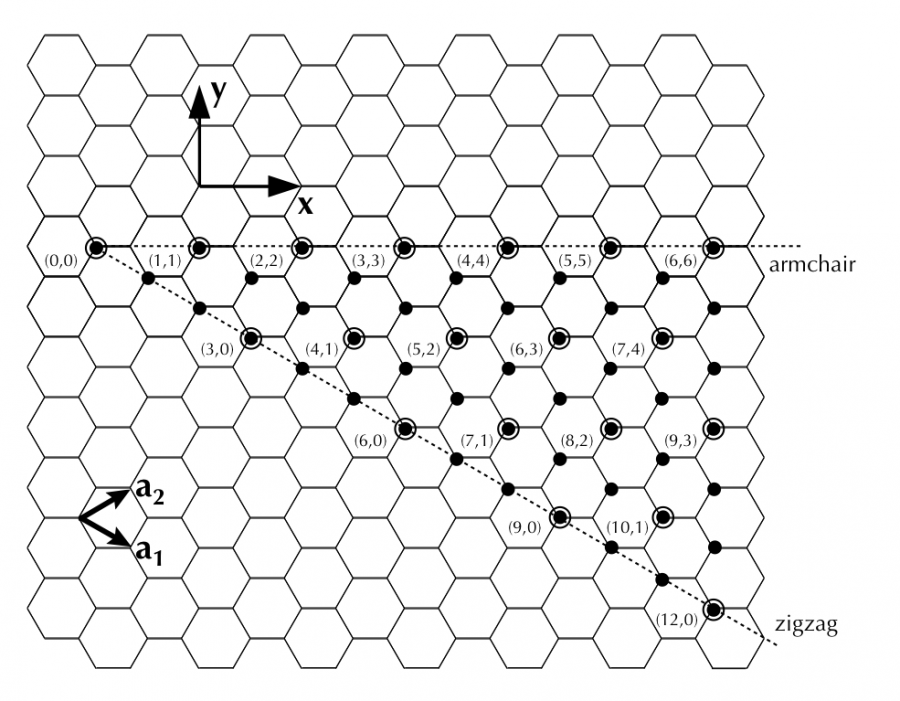TubeGen, quite simply put, generates tubes. The kind of tubes it generates is its primary distinction: molecular nanotubes. Originally written to generate just carbon nanotubes, TubeGen now has the ability to generate both periodic and discrete molecular input files for a variety of packages in both the basic Carbon-Carbon flavor as well as alternate compositions (Boron-Nitride, for example).
TubeGen was developed with the financial support of the National Science Foundation. Source code is available by request (please email me, freyguy77 [at] gmail [dot] com).
SWCNT basics
 A portion of a 2D sheet of graphite is shown at the right. Picking one carbon atom as the origin, the figure also shows the equivalent lattice points corresponding to different chirality indices. A chirality index is composed of two integer coefficients (n and m) for a linear combination of the basis vectors a1 and a2 of the 2D periodic lattice of graphite; the resulting vector is called the chiral vector, Ch. There are two highly-symmetric directions in the lattice which yield so-called armchair and zigzag nanotubes. These names are derived from the arrangement of the carbon atoms in the vicinity of the chiral vector. Armchair tubules feature two atoms on the chiral vector followed by two atoms off the vector while zigzag tubules have one atom off and on the vector alternately. The armchair moniker comes from two successive on-vector pairs being the arms of a chair while the off-vector pair between them is the seat. Carbon nanotubes may be metallic or semiconducting based upon what region of the graphite Brillouin zone they quantize (equivalent lattice positions in the figure at left that are circled are metallic).
A portion of a 2D sheet of graphite is shown at the right. Picking one carbon atom as the origin, the figure also shows the equivalent lattice points corresponding to different chirality indices. A chirality index is composed of two integer coefficients (n and m) for a linear combination of the basis vectors a1 and a2 of the 2D periodic lattice of graphite; the resulting vector is called the chiral vector, Ch. There are two highly-symmetric directions in the lattice which yield so-called armchair and zigzag nanotubes. These names are derived from the arrangement of the carbon atoms in the vicinity of the chiral vector. Armchair tubules feature two atoms on the chiral vector followed by two atoms off the vector while zigzag tubules have one atom off and on the vector alternately. The armchair moniker comes from two successive on-vector pairs being the arms of a chair while the off-vector pair between them is the seat. Carbon nanotubes may be metallic or semiconducting based upon what region of the graphite Brillouin zone they quantize (equivalent lattice positions in the figure at left that are circled are metallic).
 The chiral vector determines what section of the graphite sheet must be extracted to form the crystalline basis of the rolled SWCNT. The chiral vector wraps the circumference of a cylinder and the tubule translation vector, Tv is aligned with the cylinder's axis.
The chiral vector determines what section of the graphite sheet must be extracted to form the crystalline basis of the rolled SWCNT. The chiral vector wraps the circumference of a cylinder and the tubule translation vector, Tv is aligned with the cylinder's axis.
From the chirality indices, TubeGen calculates all of the pertinent vectors and maps the 2D graphitic positions onto a cylinder of the appropriate radius. It corrects for the bond shortening that occurs as a result of “wrapping” a 2D atomic bond onto a 3D surface to keep all atoms consistently far apart. The resulting crystalline basis can be output in a variety of formats.
A more extensive discussion of the workings inside TubeGen are presented in Chapter 6 of my thesis:
- Quantum chemical studies of scanning tunneling microscopy and spectroscopy. Frey, Jeffrey T. University of Delaware, ProQuest, UMI Dissertations Publishing, 2006.
Links
TubeGen online
A web-based front end to the TubeGen utility is available for limited production of tubules. If your requirements exceed the chirality/size limits imposed on the web front end, then please email me to request the source code so you can compile and run the utility locally.
Graphite and Diamond generators
TubeGen is written in C++ and many of the component classes are easily reused to build other software. To point, there are two additional utilities included in the source package: a diamond lattice generator and a graphite generator. Both have web-based front ends, as well:
